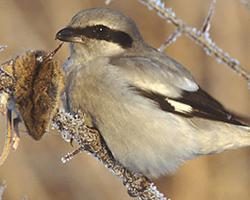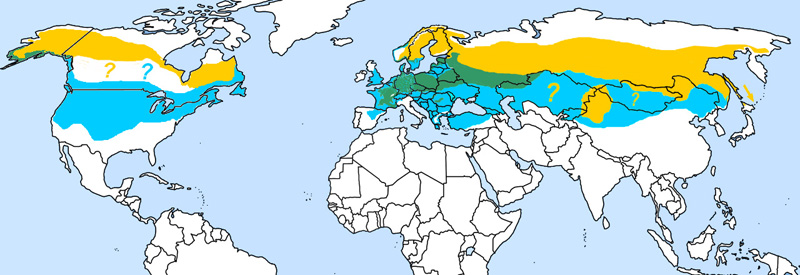
Stav ohrožení
| Ohrožen |
Popis zvířete
The Great Grey Shrike (Lanius excubitor), often referred to as the Northern Shrike in North America, is a fascinating and somewhat enigmatic bird species that belongs to the family Laniidae, which is known for its members' unique hunting behaviors and distinctive appearance. This bird of prey is found across the Northern Hemisphere, inhabiting a wide range of environments, from dense forests to open scrublands, though it shows a preference for areas with scattered trees and bushes which facilitate its hunting strategy.Characterized by its striking plumage, the Great Grey Shrike is predominantly grey, with a black mask that extends across its eyes and down the sides of its neck, a feature that is not only distinctive but also adds a hint of ferocity to its appearance. The underparts are a paler grey or white, and the wings are black with a conspicuous white patch, visible during flight. The long tail is edged with white, and the bird's overall length can reach up to 25 centimeters, making it one of the larger species within the shrike family.
The Great Grey Shrike is a solitary hunter, known for its remarkable and somewhat gruesome method of securing prey. It feeds on a diet consisting mainly of insects, small mammals, birds, and amphibians. What sets this bird apart from other predators is its habit of impaling its captured prey on thorns or barbed wire, creating a 'larder' which it can return to when food is scarce. This behavior has earned it the nickname of "butcher bird."
Equipped with a strong, hooked beak, the Great Grey Shrike is well-adapted to its carnivorous diet, using its sharp bill to kill prey and then often to skewer it. Despite its predatory nature, the bird is also known for its melodious song, which it uses to communicate with others of its kind, especially during the breeding season.
Breeding typically takes place in the spring, with the Great Grey Shrike being monogamous during the season. Nests are constructed in trees or shrubs, where the female lays a clutch of 4 to 7 eggs. Both parents take part in feeding the chicks until they are ready to fledge.
As a species, the Great Grey Shrike is of least concern according to the IUCN Red List, though its populations are monitored due to habitat loss and changes in agricultural practices that could potentially impact its numbers. Despite this, the Great Grey Shrike continues to thrive in suitable habitats across its range, captivating birdwatchers and nature enthusiasts with its unique behaviors and striking appearance.
Mapa výskytu

Podobná zvířata
Nové fotografie zvířat
Top 10 zvířat
- Dolphin gull (Leucophaeus scoresbii)
- Diana monkey (Cercopithecus diana)
- Stone loach (Barbatula barbatula)
- Greek tortoise (Testudo graeca)
- Moustached guenon (Cercopithecus cephus)
- Japanese macaque (Macaca fuscata)
- Galápagos tortoise (Geochelone nigra complex)
- Russian tortoise (Testudo horsfieldii)
- Galápagos penguin (Spheniscus mendiculus)
- Common flying dragon (Draco volans)

